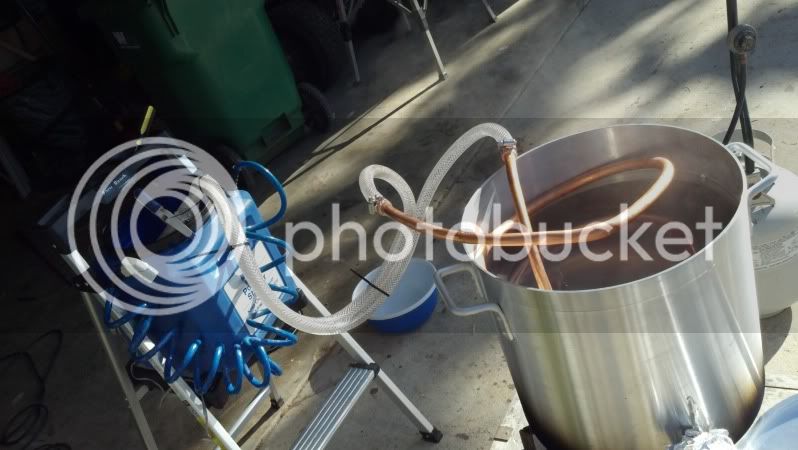Hey Guys,
New to posting here. Been lurking for a few weeks now. Last night I put together a quick and cheap recirculating IC, but have a question about the cooling capacity. I piggybacked off a bilge pump that I have for a portable "Big Kahuna" surfing shower. The vinyl line that fed from the pump just so happened to have a large enough ID for the vinyl tubing I had to fit snug inside (with extra insurance from a hose clamp). The pump works off of DC power and seems to pull with enough power to push water up and through a 20ft coil and back into the 6.6gal receptacle. I was able to get my hot water (i was testing the system) from boiling to 160F in about 6 minutes. However, it took a whole lot of ice to keep the returning water in the receptacle to stay around 80F. At the end of the day, my kettle water fell to around 90F in about 20-25 minutes. I saw the system worked and cut the day there.
My question is such,
At what volume of water, would sustain a great enough cooling capacity to avoid constantly adding ice to the circulation? I recognize my 6.6gal receptacle may not be overly efficient, but it was cheap and simple to assemble. If it comes to it, I am in the position to buy a 25 dollar bilge pump and throw it into a large party keg bath bucket thing. Might this be an arbitrary inquiry, given the nature of the pump's strength and ambient temperature, I only seek a ballpark guesstimation.
Cheers all!
heres the only picture I snapped

and a link to the hardware
http://bigkahunashowers.com/
New to posting here. Been lurking for a few weeks now. Last night I put together a quick and cheap recirculating IC, but have a question about the cooling capacity. I piggybacked off a bilge pump that I have for a portable "Big Kahuna" surfing shower. The vinyl line that fed from the pump just so happened to have a large enough ID for the vinyl tubing I had to fit snug inside (with extra insurance from a hose clamp). The pump works off of DC power and seems to pull with enough power to push water up and through a 20ft coil and back into the 6.6gal receptacle. I was able to get my hot water (i was testing the system) from boiling to 160F in about 6 minutes. However, it took a whole lot of ice to keep the returning water in the receptacle to stay around 80F. At the end of the day, my kettle water fell to around 90F in about 20-25 minutes. I saw the system worked and cut the day there.
My question is such,
At what volume of water, would sustain a great enough cooling capacity to avoid constantly adding ice to the circulation? I recognize my 6.6gal receptacle may not be overly efficient, but it was cheap and simple to assemble. If it comes to it, I am in the position to buy a 25 dollar bilge pump and throw it into a large party keg bath bucket thing. Might this be an arbitrary inquiry, given the nature of the pump's strength and ambient temperature, I only seek a ballpark guesstimation.
Cheers all!

heres the only picture I snapped

and a link to the hardware
http://bigkahunashowers.com/


